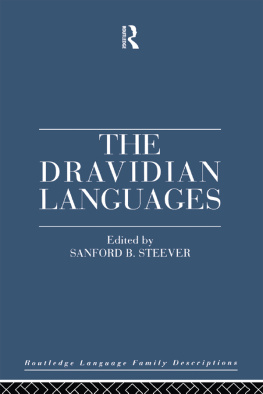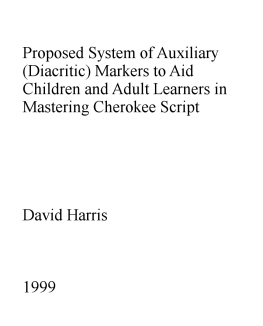The Tamil Auxiliary Verb System
The Tamil Auxiliary Verb System introduces the syntactic process of auxiliary formation and applies it to the grammatical analysis of the indicative, or non-modal, auxiliary verbs of Modern Tamil. Data from the spoken and written registers, gathered over several years, form the basis of this synchronic study, which focuses on the semantic and syntactic properties of twenty-four auxiliary verbs.
This book demonstrates for the first time the systematic nature of auxiliary verb phenomena and how they are integrated into the grammar of the language. Discoveries are presented at several levels of Tamil grammar: morphology, syntax, semantics and pragmatics, new constructions, verbal categories and tenses are all analysed. This book will have further implications for historical and typological linguistics, particularly as they bear on the formation of the compound verbs as an isogloss feature of the South Asian linguistic area.
The Tamil Auxiliary Verb System will be of interest to linguists, Dravidian scholars and students of Tamil.
Sanford B. Steever holds three degrees in linguistics and a diploma in Tamil. The author of four books and fifty articles on Historical Linguistics, Syntax, Dravidian Linguistics and Tamil, he spent three years of study and fieldwork in India. He is the editor of The Dravidian Language (1997).
Routledge Asian Linguistics Series
Editor-in-Chief:
Walter Bisang, Mainz University
Associate Editors:
R. V. Dhongde, Deccan College, Pune and Masayoshi Shibatani, Rice University, Texas
Asia is the worlds largest continent, comprising an enormous wealth of languages, both in its present as well as in its eventful past. The series contributes to the understanding of this linguistic variety by publishing books from different theoretical backgrounds and different methodological approaches, dealing with at least one Asian language. By adopting a maximally integrative policy, the editors of the series hope to promote theoretical discussions whose solutions may, in turn, help to overcome the theoretical lean towards West European languages and thus provide a deeper understanding of Asian linguistic structures and of human language in general.
VIETNAMESE-ENGLISH BILINGUALISM
Patterns of code-switching
Ho-Dac Tuc
LINGUISTIC EPIDEMIOLOGY Semantics and grammar of language contact in mainland Southeast Asia
Nick J. Enfield
A GRAMMAR OF MANGGHUER
A Mongolic language of Chinas Qinghai-Gansu Sprachbund
Keith W. Slater
FUNCTIONAL STRUCTURE(S), FORM AND INTERPRETATION
Perspectives from East Asian languages
Edited by Yen-hui Audrey Li and Andrew Simpson
FOCUS AND BACKGROUND MARKING IN MANDARIN CHINESE
System and theory behind cai, jiu, dou and ye
Daniel Hole
GRAMMATICALIZATION AND LANGUAGE CHANGE IN CHINESE
A formal view Xiu-Zhi Zoe Wu
TAMIL AUXILIARY VERB SYSTEM
Sanford B. Steever
First published 2005 by Routledge
2 Park Square, Milton Park, Abingdon, Oxon OX 14 4RN
Simultaneously published in the USA and Canada
by Routledge
52 Vanderbilt Avenue, New York, NY 10017
Routledge is an imprint of the Taylor & Francis Group
2005 Sanford B. Steever
Typeset in New Times Roman and Transindic Transliterator by SBS
All rights reserved. No part of this book may be reprinted or reproduced or utilised in any form or by any electronic, mechanical, or other means, now known or hereafter invented, including photocopying and recording, or in any information storage or retrieval system, without permission in writing from the publishers.
British Library Cataloguing in Publication Data
A catalogue record for this book is available from the British Library
Library of Congress Cataloguing in Publication Data
A catalog record for this book has been requested
ISBN 0-415-34672-X
How does a bookan entire bookcome to be written on the Tamil auxiliary verb system? My interest in the topic dates back thirty years when I began to study the language. Almost from the beginning, it became clear that I would not be able to navigate a sentence of the language, much less hold a conversation, without coming to grips with auxiliary verbs. That these phenomena came to loom so large in my consciousness now seems to me to be due to two facets of Tamil grammar. First, the language distinguishes just two major parts of speech, noun and verb. Second, and cognizant of the need to describe languages sui generis, verbs in Tamil are from a cross-linguistic perspective endowed with relatively modest inflections. These two factors narrowed my attention until it came to rest on one of the primary ways in which Tamil elaborates its system of basic verb forms: through the generation of numerous auxiliary verb constructions.
Studying Tamil was just one current in my linguistics education. As a graduate student at Chicago, I concentrated mainly on the trinity of syntax, semantics and pragmatics, although my eye would also wander to phonetics, morphology, typology and historical linguistics, particularly comparative Dravidian linguistics. After three years of course work in Chicago, I spent a year in Tamil Nadu to sharpen my Tamil language skills, and perhaps find myself a dissertation topic. In the end, four years of courses, including one year of intensive study, proved insufficient to answer all my questions about Tamil auxiliaries, and following examinations in Chicago, I returned to India on a research fellowship to carry out research on the syntax, semantics and pragmatics of the Tamil auxiliary verb system. The book now before you is a reworking of my doctoral dissertation, A study in auxiliation: the grammar of the indicative auxiliary verb system of Tamil, which was submitted to the Linguistics Department of the University of Chicago two decades ago.
In a field that evolves as rapidly as linguistics, publishing a work so long after its initial composition may entail a number of risks, not the least of which concerns its relevance to current linguistic issues. Nevertheless, several reasons may be cited for undertaking a revision of this work which seem to outweigh the risks that its publication might raise. They are noted here briefly starting with the more specific ones, of interest primarily to specialists in Tamil, and progressing to the more general, of concern to general linguists who might otherwise feel no need to consult a specialist study of the Tamil verb system.
First, apart from a scattering of articles, virtually nothing new has been published on the Tamil auxiliary verb system in the intervening twenty years, and the fate of many a dissertationthose few that have made it into print do not take into account the findings originally presented in my dissertation. As a consequence, many of the conclusions drawn here, as well as the data and arguments on which they rest, are made explicit for the first time. The original contents have been supplemented with further material gathered during a third, postdoctoral year in India, as well as examples from my continued reading of modern linguistics and Tamil literature. Tamil grammatical phenomena in fields as diverse as morphology and semantics, syntax and pragmatics, are extensively described and analyzed here for the first time; in other instances, new interpretations are given to a number of phenomena obliquely noted in the literature, but barely touched upon. Given its breadth of coverage, then, this book may among its other uses serve as a reference work for Tamil verbal morphology and syntax.





